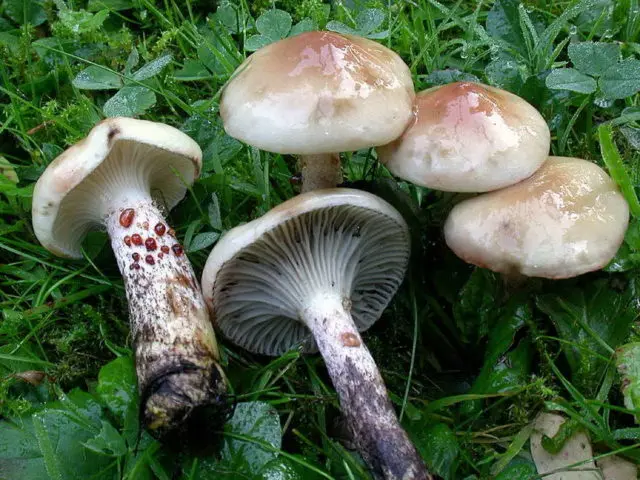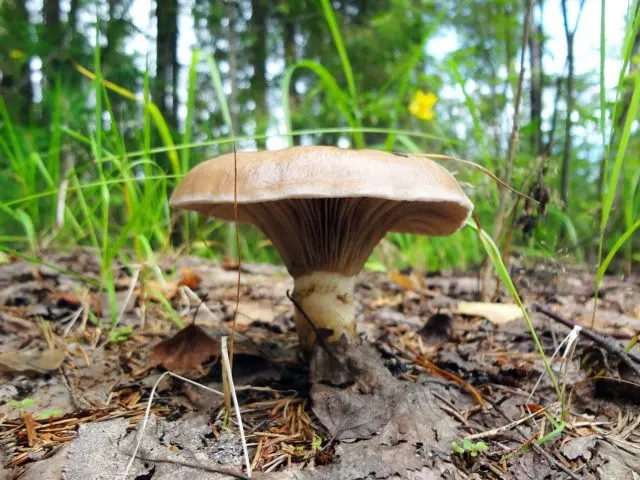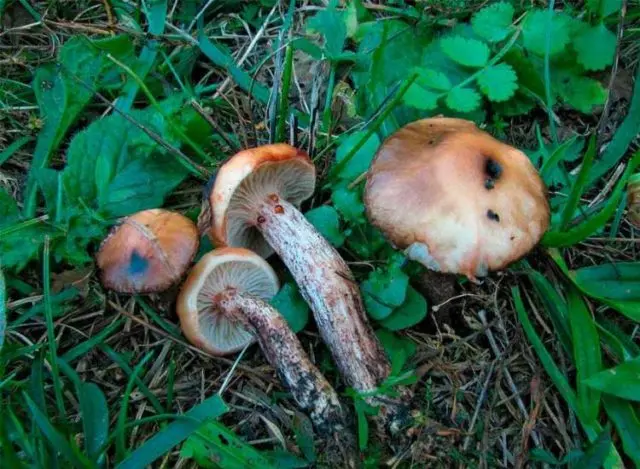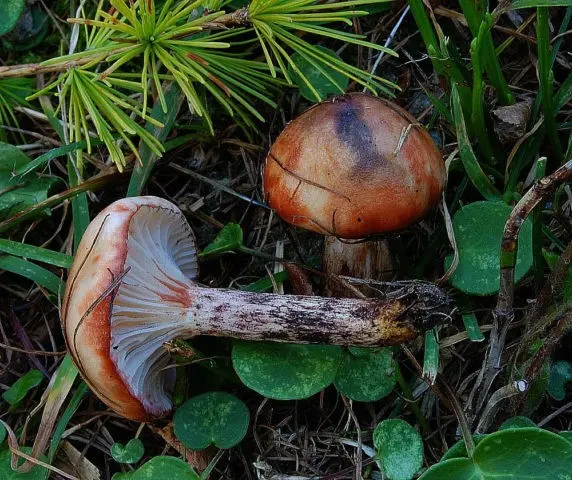Contents
Mokruha spotted refers to agaric mushrooms. It is the most common variety of the genus of the same name. It is important for avid and novice mushroom pickers to know what this unusual representative of the forest kingdom looks like and what is its nutritional value.
What do mokruhi spotted look like
The unusual appearance of mokruhe is given by the mucus covering its surface. This feature gave the name to the whole family: the fruiting bodies appear wet.

The mushroom is notable for its large cap (from 2,5 to 5,5 cm in diameter). The layer of mucus is especially thick on its surface. At an early stage of growth, the cap of the spotted mokruha has a cone-shaped shape, but over time it becomes flat, with open, slightly depressed edges. The surface of the fungus is painted gray, it contains characteristic dark blotches.

The leg with a diameter of up to 1,5 cm is off-white in color, while it seems swollen, as it expands and brightens upward. It is mustard at the base, may have dark gray or black spots, and be curved. The mucus is not expressed, however, at the cap itself, a massive ring forms from it. The leg reaches a height of 8 cm. It is dense in structure.

The loose light pulp of a young mushroom turns pink when broken, and in old specimens it becomes brown. Grayish plates of mature mokruha turn black.
Where do mokruha spotted grow
A variety grows in Eurasia, North America. It can be found in small groups in rare thickets of shrubs, among mosses. The fungus prefers conifers, with which it forms mycorrhiza (most of all with spruce and larch), as well as mixed forests.
Is it possible to eat mokruhi spotted
Mokruha spotted belongs to conditionally edible mushrooms. Before cooking, the fruiting bodies are boiled for at least half an hour. This species is used in salting, pickled. Cooked mushrooms are distinguished by a pleasant, butter-like taste, fleshy pulp and good aroma.
False doubles
Spotted Mokruha has no twins. External similarities can only be found with other members of the family.

Collection rules
Although it is rather difficult to confuse the spotted mokruha with other varieties, it is necessary to consult the description, and, in case of any doubt about the identity, it is better to leave the mushroom in place. Follow the standard rules:
- It is best to go mushroom picking early in the morning.
- The best time will be after heavy rainfall, which significantly increases the level of productivity.
- It is strongly not recommended to collect spotted mokruha in urban areas, near highways, railways, and chemical industries. In such areas, mushrooms absorb heavy metals, toxins, exhaust gases.
- For mushroom hunting, it is best to wear boots or high boots, as well as things made of thick fabric.
- Do not cut rotten, overripe, wormy or flabby specimens. Such spotted mokruhi will quickly decompose, while releasing substances that are toxic to the body.
- For picking mushrooms, it is best to use wicker baskets with good ventilation or metal buckets. Do not put the fruiting bodies in a plastic bag: in this form they will suffocate and quickly deteriorate.
- Having found a spotted mokruha, you should not pull it out of the soil: this way you can destroy the mycelium, because of which the yield on the site will stop for several years. It is enough to carefully cut the fruiting body under the root with a knife.
Use
In addition to salting and pickling, spotted mokruhi are good for making broths, sauces, side dishes for meat and fish dishes, and also as a unique ingredient in salads.
The use of mokruha spotted carries a number of useful properties, due to the presence of enzymes in the composition of the fungus, which are used in the manufacture of antibiotics.
In the fruit bodies there is a complex of amino acids, trace elements and vitamins. According to the concentration of protein in the composition of mokruha, spotted ones are compared with meat, which is why the product is included in the vegetarian menu.

The use of the mushroom has a beneficial effect on the quality of brain activity, the state of the immune system. The product helps to eliminate fatigue, increase the overall tone of the body, improve the blood formula.
In the field of traditional medicine, spotted mokruha is also used to combat migraines, insomnia, weakness and nervous disorders.
Conclusion
Mokruha spotted is the most common variety. Like the rest of the genus, this fungus has a peculiarity: a fruiting body covered with mucus. The species does not have false twins, it is classified as conditionally edible. Use in cooking is possible after preliminary boiling.









